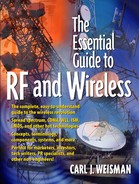BLOCK DIAGRAMS
Transmitters and receivers are very complex systems with many internal components, but all transmitters and receivers perform the same basic functions and they can both be described by simple block diagrams (see Figures 3-1 and 3-2). In these figures, the signals flow from left to right. The weird shaped things are the components and the straight lines are the conductors which connect them. As can be seen in these block diagrams, a signal gets from one component to another by way of a conductor. Recall that a receiver turns an airborne wave into an electrical signal and a transmitter turns an electrical signal into an airborne wave.
Receiver
Figure 3-1. Receiver block diagram.

Transmitter
Figure 3-2. Transmitter block diagram.

At their simplest, all transmitters and receivers consist of just five basic building blocks. (Notice in Figures 3-1 and 3-2 there are only five distinct items in each block diagram, although some of them are repeated.) Once you understand these five building blocks and what functions they perform, you are half way to understanding RF systems and wireless communications. (You will learn about the other half in the section on Modulation.) I will discuss each of these building blocks and what roles they perform in a wireless system.
